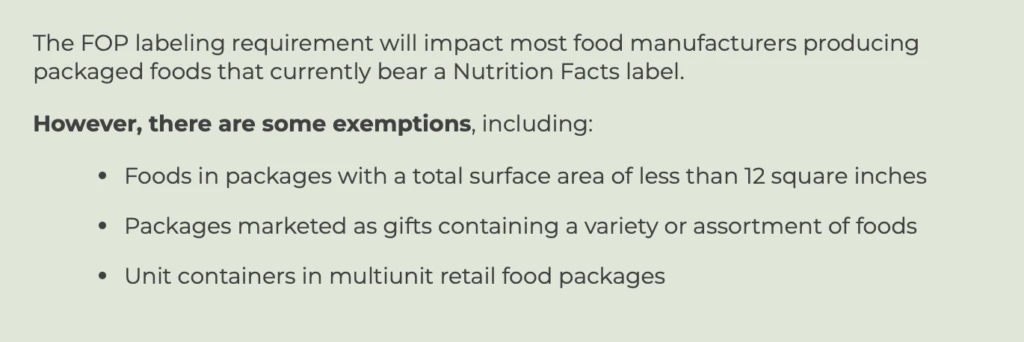If it navigates a poltical gauntlet, FDA’s proposed nutritional label could actually have constructive impact
If it navigates a poltical gauntlet, FDA’s proposed nutritional label could actually have constructive impact

The proposed “Nutrition Info box” is set to transform how Americans shop for food, offering a quick “Low,” “Med,” or “High” snapshot of saturated fat, sodium, and added sugars content. And it has been a long time coming.
…
Driven by the alarming prevalence of chronic diseases and escalating healthcare costs, the FDA’s initiative goes beyond mere labeling—it’s a strategic intervention aimed at empowering consumers to make more informed dietary choices.
The FDA’s proposed rule on FOP nutrition labeling is currently open for public comments until May 16, 2025. After this period, the FDA will review the comments and potentially make revisions before issuing a final rule, which can take several years. Once finalized, large companies with $10MM+ in food sales have 3 years to implement; small companies have 4 years.
…
What are the economic impacts to the food industry?
Here are some of the potential economic impacts on the food industry:
- Reformulation Costs: Many food manufacturers are likely to reformulate their products to meet new “healthy” criteria. This could lead to substantial upfront research and development expenses until economies of scale are achieved
- Price Changes: There’s evidence of a 5.5% increase in prices of unlabeled products relative to labeled ones due to regulations. This suggests that companies may adjust pricing strategies to offset costs or capitalize on perceived healthier options.
- Demand Shifts: Products receiving labels, especially those previously perceived as healthy, could experience up to a 40% decrease in demand. This may lead to revenue losses for some manufacturers and gains for others producing healthier alternatives.
- Compliance Costs: The industry will face expenses related to implementing new labeling requirements, including design changes and printing costs.
- Potential Cost Savings for U.S.: Despite initial costs, the regulations could lead to long-term healthcare and societal cost savings. The US calorie menu labeling law alone is estimated to result in net lifetime savings of $10.42 billion from a healthcare perspective and $12.71 billion from a societal perspective.
- Market Differentiation: Some companies may benefit from increased product differentiation, potentially allowing for premium pricing of healthier options.
- Industry-wide Impact: Experts estimate that food fraud, which stricter labeling aims to combat, affects 1% of the global food industry at a cost of about $10-$15 billion annually. New regulations could help reduce these losses.

While the US is moving towards more transparent FOP labeling, its proposed regulations appear to be less stringent than those in some other countries, particularly in identifying ultra-processed products. The approach differs from the EU’s color-coded system and the more comprehensive labeling requirements seen in countries like Chile.
This is an excerpt. Read the original post here

 | Videos | More... |

Video: Nuclear energy will destroy us? Global warming is an existential threat? Chemicals are massacring bees? Donate to the Green Industrial Complex!
 | Bees & Pollinators | More... |

GLP podcast: Science journalism is a mess. Here’s how to fix it

Mosquito massacre: Can we safely tackle malaria with a CRISPR gene drive?

Are we facing an ‘Insect Apocalypse’ caused by ‘intensive, industrial’ farming and agricultural chemicals? The media say yes; Science says ‘no’
 | Infographics | More... |

Infographic: Global regulatory and health research agencies on whether glyphosate causes cancer
 | GMO FAQs | More... |

Why is there controversy over GMO foods but not GMO drugs?

How are GMOs labeled around the world?

How does genetic engineering differ from conventional breeding?
 | GLP Profiles | More... |

Alex Jones: Right-wing conspiracy theorist stokes fear of GMOs, pesticides to sell ‘health supplements’




 From plastic coasters to human hearts: Inside the race to print the human body
From plastic coasters to human hearts: Inside the race to print the human body A single high dose of LSD can ease anxiety and depression for months
A single high dose of LSD can ease anxiety and depression for months CRISPR pork: U.S. approves first gene-edited pigs for consumption
CRISPR pork: U.S. approves first gene-edited pigs for consumption ‘SuperAgers’: Why some people have the brains and memory capacity of people decades younger
‘SuperAgers’: Why some people have the brains and memory capacity of people decades younger  Baby food panic, brought to you by trial lawyers hoping to prosecute by press release
Baby food panic, brought to you by trial lawyers hoping to prosecute by press release From ‘Frankenfood’ to superfood: Can the purple tomato overcome GMO myths to win over consumers?
From ‘Frankenfood’ to superfood: Can the purple tomato overcome GMO myths to win over consumers? Viewpoint: Life and death decisions: RFK, Jr.’s shady FDA “expert panels” operate in secret with no transcripts or conflict of interest reviews
Viewpoint: Life and death decisions: RFK, Jr.’s shady FDA “expert panels” operate in secret with no transcripts or conflict of interest reviews When farmers deny science: The hypocrisy hurting agriculture’s credibility
When farmers deny science: The hypocrisy hurting agriculture’s credibility
